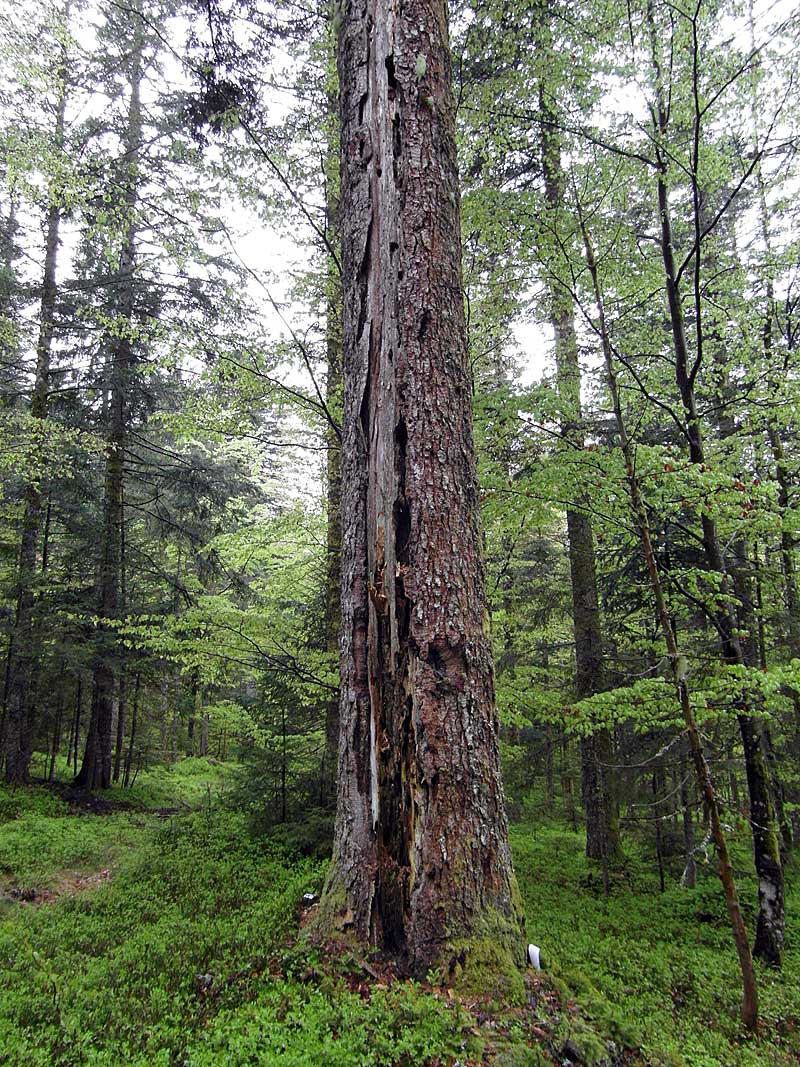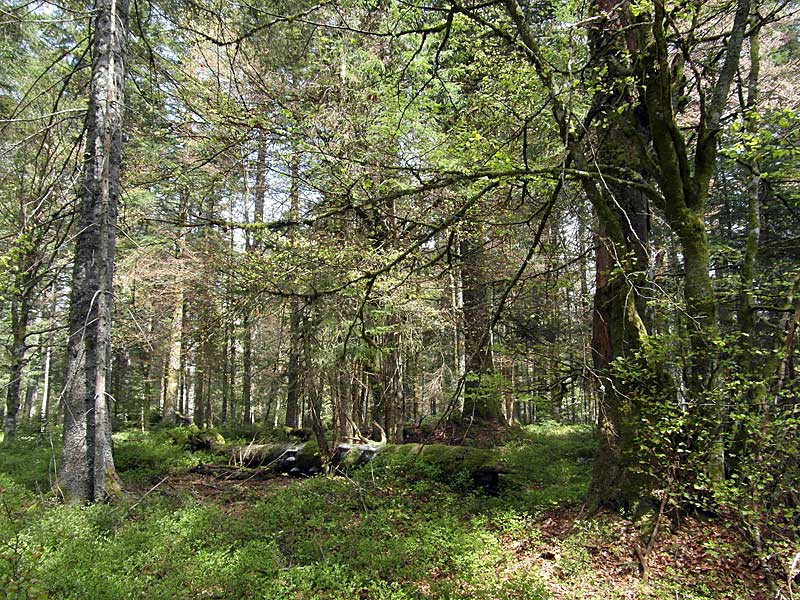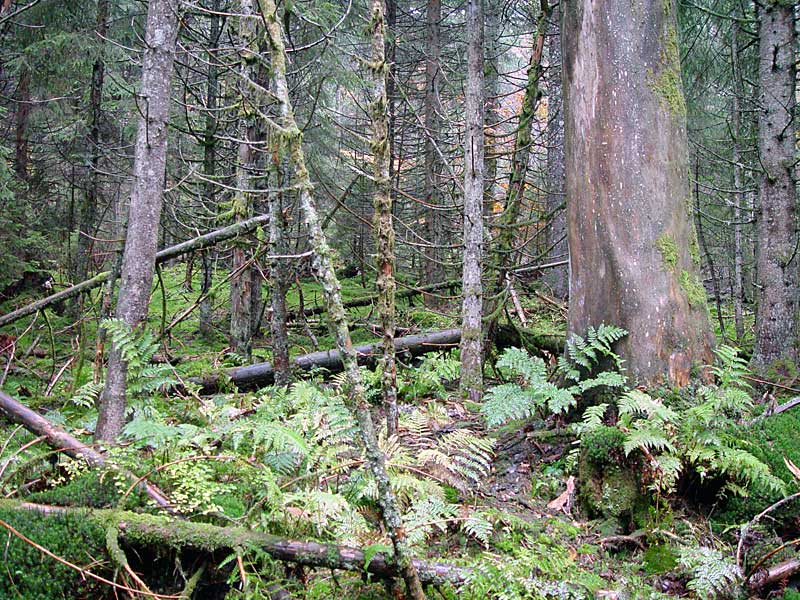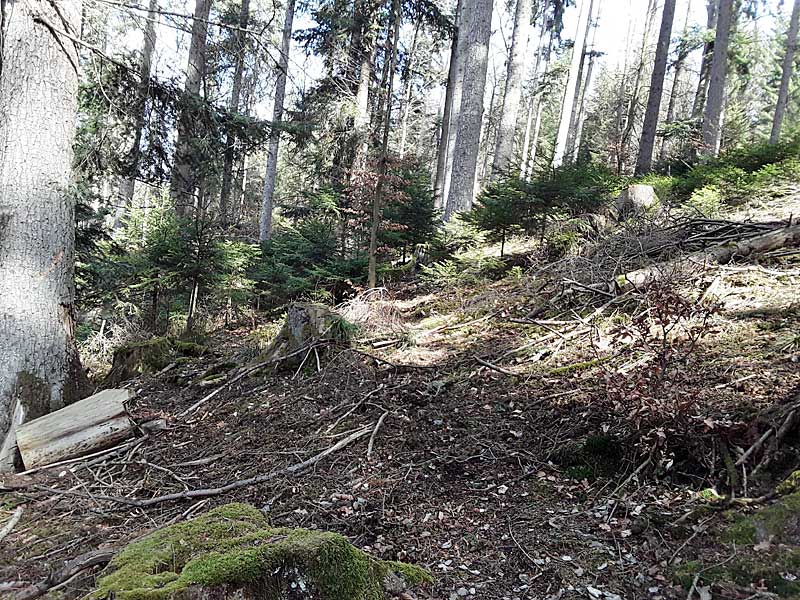Influence of forest management on the number and diversity of tree microhabitats

Fig. 1: Beech habitat tree with epiphytes.
Tree microhabitats are a key criterion for habitat trees. In addition, their number and diversity make it possible to show the conservation value of forest stands. This case study shows to what extent the abundance and diversity of tree microhabitats in mixed mountain forests are changed by forestry management and how habitat trees contribute to the preservation of tree microhabitats.
Background
Several practice-oriented concepts have already been developed to promote biodiversity in forests, e.g. the nature conservation concept of the Bavarian State Forests, and Baden-Württemberg’s overall concept for forest nature conservation and concept for old tree and deadwood management. In this context, concepts for process protection (e.g. completely protected forests or the core zones of national parks) complement integrative measures for the permanent conservation of individual or groups of habitat or biotope trees in managed forests (e.g. the old tree and deadwood concept of BW). This creates a network of habitats over the entire area, especially for species dependent on deadwood and old trees.
What are habitat trees or tree microhabitats?

Fig. 2: Silver fir with extensive bark damage, a designated habitat tree.
Habitat trees are the smallest element of process protection to be integrated into forest management. They should stand out from the surrounding stand by offering several so-called key structures or tree microhabitats (hereafter microhabitats) (Figs. 1, 2). Microhabitats are structural elements, usually small anomalies or signs of age in the tree structure (e.g. crown deadwood, epiphytes, cavities), that increase the ecological value of a tree. They are a key factor of influence in the selection of habitat trees.
Microhabitats can be used to establish links to the occurrence of species and their diversity in forests. In comparison with the species dependent on them, microhabitats are easy to identify and reasonably straightforward to survey.
So far, it has been possible to identify certain factors that explain the occurrence of microhabitats. The tree species is the first obvious factor. Deciduous trees tend to offer more microhabitats than conifers. As well as the diameter of a tree, its vitality is another influencing factor. Dead trees have significantly more microhabitats than living ones. Very little research has been conducted so far into the extent to which forest management influences the frequency and diversity of microhabitats. The results of the few previous studies on this are also inconclusive. For the first time, a concrete dependence on stand structure (even-aged, uneven-aged) could be demonstrated for 15 different microhabitat types.
The case study presented here is being carried out in the Oberer Hotzenwald area in the southern Black Forest. It aims:
- to show the abundance and diversity of microhabitats in mixed mountain forest stands with different levels of intervention;
- to investigate the influence of management on the abundance and diversity of microhabitats; and
- to show the extent to which the microhabitat-richness of habitat trees is favoured by taking structural aspects into account in their selection.
Provision of microhabitats: Habitat trees versus comparison trees

Fig. 3: Area of low rate of forestry use with lying deadwood, colonised by perennial poroid fungi (Polyporus) and moss.
The most common tree species among the comparison and habitat trees was fir, followed by spruce and beech. The second most common tree species among the habitat trees was beech, followed by sycamore maple (not considered further here) and spruce. The mean diameter at breast height (BHD) of the comparison trees was 56.5 cm and thus significantly lower than that of the habitat trees, which was 71.8 cm. About half as many microhabitats were found on comparison trees as on designated habitat trees. The microhabitat richness of the habitat trees is significantly greater than that of the comparison trees. On average, 276 microhabitats per hectare were found in the sample circles without habitat trees (excluding dead trees).
Apart from grouped insect boreholes (so-called insect galleries), the only cavities on the comparison trees were in living beech trees. Woodpecker cavities were not found at all on living trees within the sample circles. The most common injury to the comparison trees was exposed sapwood. Hardly any special bark structures, crown deadwood or nests were found on the comparison trees in the sample circles. Cavities at the base of stems were the most common growth form-related microhabitat here. The most common microhabitat in terms of numbers on comparison trees was epiphytic (attached) lichen and moss growth.
On designated habitat trees, on the other hand, crown deadwood occurred as the most common microhabitat, followed by epiphytic growth, witches' brooms and coarse bark structure. Cavities occurred more frequently on habitat trees, and woodpecker cavities (especially on spruce) were also found. Pockets in the bark and exposed heartwood or sapwood were also found more frequently on habitat trees than on the comparison trees within the sample circles.
Intensity of utilisation and microhabitats

Fig. 4: Area with lots of standing deadwood of different dimensions.
Photo: A. Schabel
In the stands studied, the number of microhabitats per hectare increased significantly with increasing stem numbers, but the diversity of microhabitat types did not change. Consequently, the number of microhabitats decreases with the number of trees removed. As a result of timber harvesting, there are fewer trees in the stand, and fewer trees are thus damaged during subsequent harvesting measures. This in turn leads to fewer microhabitats – the mean occurrences of epiphytes, cavities and growth form-related microhabitats decrease.
Critical analysis of the results
The results of this study are only partially comparable with those of other studies. Before the introduction of the “Catalogue of tree microhabitats”, studies investigated different numbers of microhabitats with different definitions. In terms of structure and the degree of differentiation of microhabitats, the Rosskopf marteloscope (training plot) (mixed mountain forest with Douglas fir) near Freiburg is a suitable comparison plot.
In the sample circles examined in the course of this study in the Hotzenwald forest, considerably more epiphytic microhabitats were found than in the “Rosskopf” marteloscope, which is probably due to the altitude in the Hotzenwald forest. A positive correlation between epiphytic microhabitats and altitude has already been demonstrated for the Black Forest. A similarly large proportion of epiphytic microhabitats was also found in studies on the Swabian Alb.
Significantly fewer cavities, injuries and less crown deadwood were found on the comparison trees in the sample circles in proportion to the total number of trees than in comparable forest stands. This is probably because designated habitat trees and dead trees were explicitly excluded from inclusion in this evaluation.
Effect of management on provision of microhabitats

Fig. 5: More intensively utilised forest stand: Rootstocks and lying deadwood left with saw cuts.
Our results show that in the collective of comparison trees, the number of particular microhabitats, especially those with a higher conservation value, e.g. cavities, decreases with decreasing numbers of trunks per hectare. More intensive forestry utilisation has a significant effect in reducing the number of trunks, and thus results in a decrease in the abundance of microhabitats. Silvicultural measures lead to a reduction in the availability of microhabitats through the removal of trees, but may also contribute to the creation of new microhabitats through damage caused during felling and skidding operations, for example.
It was also the case that we could not find any general differences in the diversity of microhabitats between designated habitat trees and comparison trees.
Except for woodpecker cavities, all types of microhabitat were found in both tree collectives. The role played by the temporal development of microhabitats will be shown in future studies. In managed forests, the abundance of various microhabitats decreases, but they are not lost completely. Microhabitats that result in a reduction in the value of the timber, such as exposed sapwood and heartwood, or particular growth forms, occurred more frequently on designated habitat trees. Likewise, crown deadwood microhabitats, which can be a problem in terms of work safety, were also to be found significantly more frequently on designated habitat trees. Other studies have also found that the proportion of crown deadwood decreases with increasing forestry utilisation.
The abundance of microhabitats on living trees in the forest stands in this study was best explained by the number of stems, and largely determined by the number of trees with a breast height diameter (BHD) > 50 cm. The thicker the tree is, the more microhabitats are found on it. The trunks of the designated habitat trees in the study are on average thicker in diameter than the comparison trees, which partly explains why they have higher numbers of microhabitats. The microhabitat richness of the designated habitat trees is significantly greater than that of the comparison trees at a comparable BHD. This suggests that both tree dimension and richness of structure in the tree are essential for the microhabitat richness of a tree. It is not necessary to record all microhabitats here. Findings on the co-existence of certain microhabitats, e.g. on cavities in living trees and bark injuries, allow the assignment of an “indicator” function to rare microhabitats.
Conclusions
- The designation and leaving of habitat trees in the forest significantly increases structural diversity in forest stands and can presumably preserve it in the long term.
- In fact, the entire microhabitat diversity is also available in stands without designated habitat trees, albeit at a lower density (in relation to the individual tree).
- Commercial forest management reduces the abundance of microhabitats, but does not affect their diversity.
- For this conclusion to be transferred to other forest types, it should be verified on a local basis.

![[Translate to English:] [Translate to English:]](/assets/_processed_/1/6/csm_markierung_hbg_f45990323c.jpeg)
